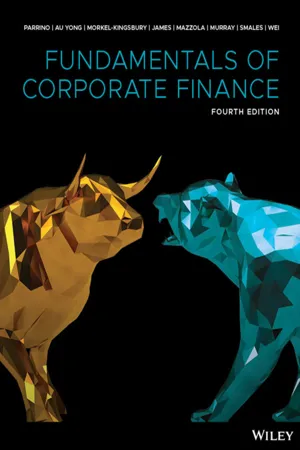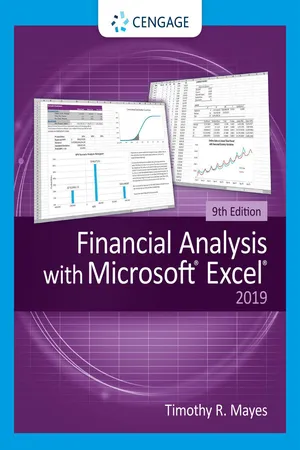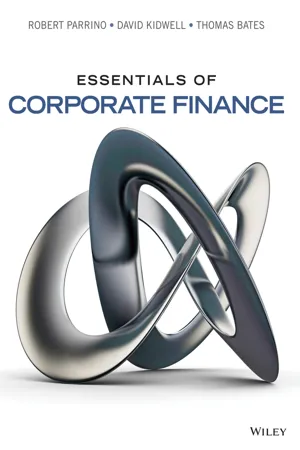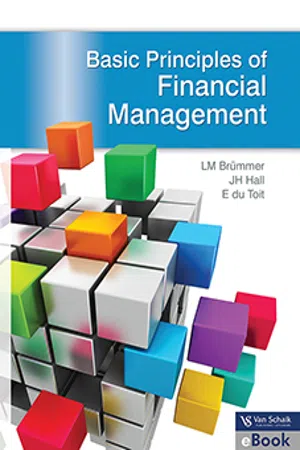Business
Future Value
Future value refers to the projected value of an investment or asset at a specified future date, based on the assumption of a certain rate of return. It is a crucial concept in finance and investment decision-making, as it helps in evaluating the potential growth and profitability of an investment over time. Calculating future value assists businesses in making informed financial planning and investment choices.
Written by Perlego with AI-assistance
Related key terms
1 of 5
8 Key excerpts on "Future Value"
- Robert Parrino, Hue Hwa Au Yong, Nigel Morkel-Kingsbury, Jennifer James, Paul Mazzola, James Murray, Lee Smales, Xiaoting Wei(Authors)
- 2020(Publication Date)
- Wiley(Publisher)
For Future Value calculations, the higher the interest rate, the faster the investment will grow. The application of the Future Value formula in business decisions is presented in section 5.2. 5.3 Explain the concept of present value and how it relates to Future Value, and use the present value formula to make business decisions. The present value is the value today of a future cash flow. Calculating the present value involves discounting future cash flows back to the present at an appropriate discount rate. The process of discounting cash flows adjusts the cash flows for the time value of money. Mathematically, the present value factor is the reciprocal of the Future Value factor, or 1/(1 + i). The calculation and application of the present value formula in business decisions are presented in section 5.3. 5.4 Discuss why the concept of compounding is not restricted to money and be able to use the Future Value formula to calculate growth rates. Any number of changes that are observed over time in the physical and social sciences follow a compound growth rate pattern. The Future Value formula can be used in calculating these growth rates. KEY TERMS compound annual growth rate (CAGR) The average annual growth rate over a specified period of time. compound interest Interest earned both on the original principal amount and on interest previously earned. compounding The process by which interest earned on an investment is reinvested so that in future periods interest is earned on the interest as well as the principal. discount rate The interest rate used in the discounting process to find the present value of future cash flows. discounting The process by which the present value of future cash flows is obtained. Future Value (FV) The value of an investment after it earns interest for one or more periods. interest on interest The interest earned on interest that was earned in previous periods.- eBook - PDF
- Peter Moles, Robert Parrino, David S. Kidwell(Authors)
- 2014(Publication Date)
- Wiley(Publisher)
Thus, the time value of money is the opportunity cost of forgoing consumption today. Applications of the time value of money focus on the trade-off between current money and money received at some future date. This is an important element in financial decisions because most investment decisions require the comparison of cash invested today with the value of expected future cash inflows. Investment opportunities are undertaken only when the value of future cash inflows exceeds the cost of the investment (the initial cash outflow). 2. Explain the concept of Future Value, including the meaning of principal amount, simple interest and compound interest , and be able to use the Future Value formula to make business decisions. The Future Value is the sum to which an investment will grow after earning interest. The principal amount is the amount of the investment. Simple interest is the interest paid on the original investment; the amount of money earned on simple interest remains constant from period to period. Compound interest includes not only simple interest, but also interest earned on the reinvestment of previously earned interest, the so-called interest on interest. For Future Value calculations, the higher the interest rate, the faster the investment will grow. The application of the Future Value formula in business decisions is presented. 3. Explain the concept of present value and how it relates to Future Value, and be able to use the present value formula to make business decisions. The present value is the value today of a future cash flow. Computing the present value involves discounting future cash flows back to the present at an appropriate discount rate. The process of discounting cash flows adjusts the cash flows for the time value of money. Computationally, the present value factor is the reciprocal of the Future Value factor, or 1/(1 þ i). The computation and application of the present value formula in business decisions is presented. - eBook - PDF
Entrepreneurial Finance for MSMEs
A Managerial Approach for Developing Markets
- Joshua Yindenaba Abor(Author)
- 2016(Publication Date)
- Palgrave Macmillan(Publisher)
Thus, the Future Value of US$1762 using compound interest is greater than US$1,600 using simple interest. 11.4 Future Value of a Lump Sum Future (or compound) value is the value at some future time of a present amount of money, or a series of payments, evaluated at a given interest rate. In other words, Future Value is the cash value of an investment at some time in the future. Assume that you deposit US$5,000 in an account earning 14 % compounded annually for ten years. What is the Future Value of the deposit? The formula for getting the Future Value is given as follows: FV PV = + ( ) 1 r n FV US = + ( ) $5 000 1 0 14 10 , . FV US US = ( ) = $ $ 5 000 3 7072 18 536 , . , Remember we mentioned that time value of money can also be solved using tables, financial calculator, and spreadsheet. We shall focus on the use of time value of money tables and financial calculators. Using the tables to solve the problem, the equation can be rewritten as follows: FV PV = ( ) FVIF r n , The (1 + r) n in the equation FV = PV(1 + r) n is replaced by a Future Value interest factor(FVIF) at a specific interest rate (r) and a specified time period (n). We can get the (FVIF)from the table (Appendix B-1 of this book) by going to 14 % interest rate in the column and looking down in the row to periods (n) of 10 and obtaining 3.70. We then put this value in the equation to arrive at: FV US US = ( ) = $ $ 5 000 3 7072 18 536 , . , Using a financial calculator, we need to appreciate that there are five key registers on the calculator and these are defined as follows: 266 Entrepreneurial Finance for MSMEs N = the number of periods I/Y = the interest rate per period PV = present value PMT = the amount of payment per period FV = Future Value CPT = is the register used to request the computation of any of the five values. In order to solve for the any of the five items, you key in any four items and then request for the computation of the fifth item. - eBook - PDF
- Robert Parrino, David S. Kidwell, Thomas Bates, Stuart L. Gillan(Authors)
- 2021(Publication Date)
- Wiley(Publisher)
5-28 CHAPTER 5 The Time Value of Money interest earned on interest. For Future Value calculations, the higher the interest rate, the faster the investment will grow. The application of the Future Value formula in business decisions is presented in Section 5.2. 3 Explain the concept of present value and how it relates to Future Value, and use the present value formula to make business decisions. The present value is the value today of a future cash flow. Comput- ing the present value involves discounting future cash flows back to the present at an appropriate discount rate. The process of discount- ing cash flows adjusts the cash flows for the time value of money. Computationally, the present value factor is the reciprocal of the Future Value factor, or 1/(1 + i). The calculation and application of the present value formula in business decisions is presented in Section 5.3. 4 Discuss why the concept of compounding is not restricted to money, and use the Future Value formula to calculate growth rates. Any number of changes that are observed over time in the physi- cal and social sciences follow a compound growth rate pattern. The Future Value formula can be used in calculating these growth rates, as illustrated in Section 5.4. Summary of Key Equations Equation Description Formula 5.1 Future Value of an n-period investment FV n = PV × (1 + i) n 5.2 Future Value with more frequent than annual compounding FV n = PV × (1 + i/m) m×n 5.3 Future Value with continuous compounding FV ∞ = PV × e i×n 5.4 Present value of an n-period investment PV = FV n _______ (1 + i) n 5.5 Rule of 72 TDM = 72 ___ i 5.6 Future Value with general growth rate FV n = PV × (1 + g) n Self-Study Problems 5.1 Amit Patel is planning to invest $10,000 in a bank certificate of deposit (CD) for five years. The CD will pay interest of 9 percent. What is the Future Value of Amit’s investment? 5.2 Megan Gaumer expects to need $50,000 for a down payment on a house in six years. - eBook - PDF
- Timothy Mayes(Author)
- 2020(Publication Date)
- Cengage Learning EMEA(Publisher)
229 C H A P T E R 8 “A bird in the hand is worth more than two in the bush.” That old aphorism, when translated into the language of finance, becomes “A dollar today is worth more than a dollar tomorrow.” Intuitively, it probably makes sense, but why? Stated very simply, you can take that dollar today and invest it with the expectation of having more than a dollar tomorrow. Because money can be invested to grow to a larger amount in the future, we say that money has a “time value.” This concept of a time value of money underlies much of the theory of financial decision making, and you will be required to understand this material in order to complete the remaining chapters. The Time Value of Money L E A R N I N G O B J E C T I V E S : After studying this chapter, you should be able to: LO1 Explain the concept of the time value of money. LO2 Calculate the present value and Future Value of cash flows using Excel. LO3 Explain the types of cash flows encountered in financial analysis and how to adjust for each type in making time value calculations in Excel. LO4 Differentiate between the alternative compounding periods, and use Excel to compare present and Future Values under different compounding schemes. Copyright 2021 Cengage Learning. All Rights Reserved. May not be copied, scanned, or duplicated, in whole or in part. Due to electronic rights, some third party content may be suppressed from the eBook and/or eChapter(s). Editorial review has deemed that any suppressed content does not materially affect the overall learning experience. Cengage Learning reserves the right to remove additional content at any time if subsequent rights restrictions require it. CHAPTER 8 The Time Value of Money 230 Future Value Imagine that you have $1,000 available to invest. If you earn interest at the rate of 10% per year, then you will have $1,100 at the end of one year. - eBook - PDF
- Robert Parrino, David S. Kidwell, Thomas Bates(Authors)
- 2013(Publication Date)
- Wiley(Publisher)
Note that, just as financial analysts used Future Value factor tables to help with calculations before calculators and computer spreadsheets became widely available, they also used present value factor tables. Table A-2 in Appendix A at the back of this book is an example of such a table. Future Value Versus Present Value We can analyze financial decisions using either Future Value or present value techniques. Al- though the two techniques approach the decision differently, both yield the same result. Both techniques focus on the valuation of cash flows received over time. In corporate finance, Future Value problems typically measure the value of cash flows at the end of a project, whereas pres- ent value problems measure the value of cash flows at the start of a project (time zero). Finding the Interest Rate In finance, some situations require you to determine the interest rate (or discount rate) for a given future cash flow. These situations typically arise when you want to determine the re- turn on an investment. Consider a zero coupon bond, which is essentially a loan that pays no DECISION MAKING E X A M P L E 5 . 2 Picking the Best Lottery Payoff Option SITUATION: Congratulations! You have won the $1 million lottery grand prize. You have been presented with several payout alternatives, and you have to decide which one to accept. The alternatives are as follows: • $1 million today • $1.2 million lump sum in two years • $1.5 million lump sum in five years • $2 million lump sum in eight years You are intrigued by the choice of collecting the prize money today or receiving double the amount of money in the future. Which payout option should you choose? Your cousin, a stockbroker, advises you that over the long term you should be able to earn 10 percent on an investment portfolio. - eBook - ePub
- Brümmer LM, Hall JH, Du Toit E(Authors)
- 2017(Publication Date)
- Van Schaik Publishers(Publisher)
weighted average cost of capital. These concepts will be discussed later.Concluding remarks
In the following sections, we shall discuss the compounding of a present sum of money, therefore finding the Future Value of a present sum of money where interest is added to the interest previously earned on the principal. We are also going to look at finding the present value of a sum of money expected to be received in future. We are going to use different methods to do the same calculations, namely (1) formulae; (2) Future Value tables; (3) a financial calculator; and (4) an Excel spreadsheet.Future Value (FV)
How to calculate the Future Value
Supposing we had R100 now (in the present time) and we wished to invest it in a savings account for three years at 10% per annum. After the first year we would receive a return of R10, which is the interest on R100 after one year. Let us also assume that we do not withdraw our interest, but leave it in the account.At the beginning of the second year, we would have a new capital sum or principal of R110 (R100 + R10) in the account. At the end of the second year, we would earn R11 in interest on our R110 which, added to the existing amount in the savings account, would give us a new total of R121 (R110 + R11) at the beginning of the third year.At the end of the third year, we would earn R12.10 in interest, which would give us a final total of R133.10 (R121.00 + R12.10), so, in effect, an initial present value (PV) of R100, compounded at 10% per annum, gives us a Future Value (FV) of R133.10 after three years. 145The Future Value formula
From this example we may now derive a simple formula to describe the process of this calculation. A sum of R100 was compounded by 10% per annum for three years. This means that R100 multiplied by a certain compounding factor would also give us R133.10 after three years, thus R100 multiplied by a factor of 1.331 would give us R133.10. The compounding factor (which we shall refer to as the Future Value factor - eBook - PDF
- Donald E. Kieso, Jerry J. Weygandt, Terry D. Warfield(Authors)
- 2022(Publication Date)
- Wiley(Publisher)
In accounting (and finance), the phrase time value of money indicates that a dollar received today is worth more than a dollar promised at some time in the future. Why? Because of the opportunity to invest today’s dollar and receive interest on the investment. Yet, when decid- ing among investment or borrowing alternatives, it is essential to compare today’s dollar and tomorrow’s dollar on the same footing—to compare “apples to apples.” Investors do that by using the concept of present value, which has many applications in accounting. The Importance of Time Value Concepts Financial reporting uses different measurements in different situations—historical cost for equipment, net realizable value for inventories, fair value for investments. As we discussed in Chapters 1 and 3, the FASB increasingly is requiring the use of fair values in the measurement of assets and liabilities. However, for many assets and liabilities, market-based fair value information is not available. In these cases, fair value can be estimated based on the expected future cash flows related to the asset or liability. Such fair value estimates are generally considered Level 3 (most subjective) in the fair value hierarchy. They are based on unobservable inputs, such as a company’s own data or assumptions related to the expected future cash flows associated with the asset or liability. As discussed in the fair value guidance, present value techniques are used to convert expected cash flows into present values, which represent an estimate of fair value. [1] (See the FASB Codi- fication References near the end of the chapter.) Some of the applications of present value-based measurements in accounting topics, which we discuss in this text, include the following. 1 1 GAAP addresses present value as a measurements basis for a broad array of transactions, such as accounts and loans receivable [2], leases [3], postretirement benefits [4], asset impairments [5], and stock-based com- pensation [6].
Index pages curate the most relevant extracts from our library of academic textbooks. They’ve been created using an in-house natural language model (NLM), each adding context and meaning to key research topics.







